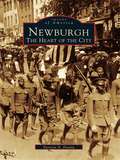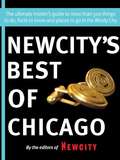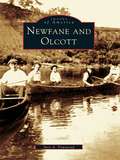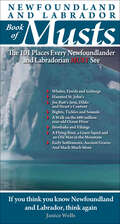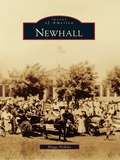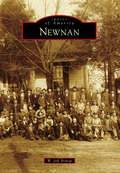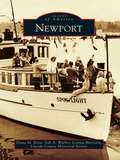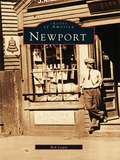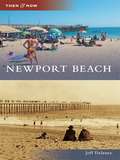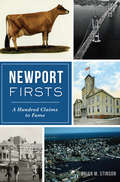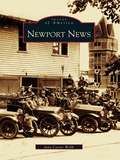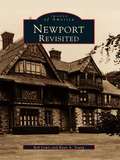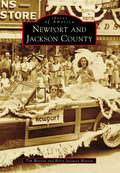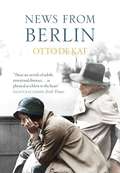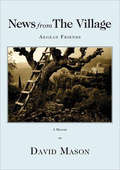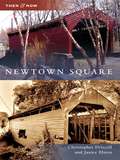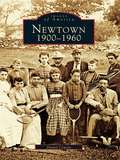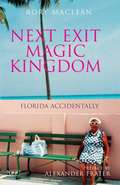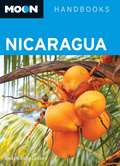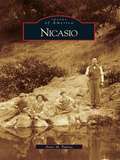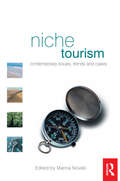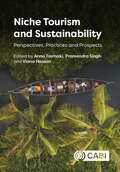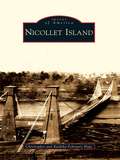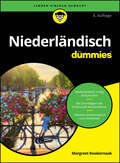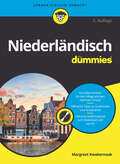- Table View
- List View
Newburgh: The Heart of the City
by Patricia A. FavataNewburgh: The Heart of the City focuses on one of the widest thoroughfares in the Northeast, Broadway, the main street in Newburgh, measuring one hundred thirty-two feet across. Known as "the heart of the city," Broadway was the activity center in the twentieth century. It was lined with government offices, commercial and business enterprises, schools, churches, restaurants, firehouses, farms, fortune-tellers, and entertainment and recreational establishments. Broadway was not only the street of everyman but also the street of presidents, playing host to both Franklin D. Roosevelt and John F. Kennedy.
Newcity's Best of Chicago 2012
by The Editors of NewcityBest of Chicago is the definitive guide to America's third-largest city, created each year, for nineteen years running, by Chicago's only locally owned and operated alternative weekly, Newcity.Unlike other city guides that trot out the same-old same-old tourist traps, Best of Chicago is equally a resource for visitors, newcomers and lifelong Chicagoans. Readers will still learn the basics like who has the best hotdog, but so too, the best place to nonchalantly check out the opposite sex. Sure, Best of Chicago will tell readers who has the best holiday-themed theatrical production. But it also has the best hipster-free bar in Wicker Park. The best Middle Eastern restaurant, the best Montreal-style poutine in Chicago, the best place to drink in the forest preserves, the best unrecognized landmark to Chicago's gay community, the best place to meet strangers over breakfast, and so on, through more than 500 entries.Entries are organized in five broad categories, including City Life, Culture & Nightlight, Food & Drink, Goods & Services, and Sports & Recreation. And not only will readers discover places to go in Chicago, but they'll learn about the city's history while enjoying a laugh or two throughout.
Newfane and Olcott
by Avis A. TownsendNewfane and Olcott are adjoining communities in western New York where residents relish the past and look toward a prosperous future. Some say they can hear the music of the big bands playing along the shoreline of Lake Ontario from the foundation of the long-demolished Olcott Beach Hotel. Others swear they can see the ghost of Malinda standing by the upstairs window of the beautiful Van Horn Mansion, guarding the grounds where her body was lost for one hundred fifty years.
Newfoundland and Labrador Book of Musts: The 101 Places Every Newfoundlander and Labradorian Must See
by Janice WellsLearn the best-kept secrets of Canada&’s charming northeastern province with this insider&’s guide for new visitors and longtime lovers of the region. From whale-watching on the shore of St. Vincent&’s and hiking Terra Nova to kissing the cod and catching greasy pigs at the largest garden party in the world, this essential volume explores the easternmost Canadian province. Highlighting the suggestions of notable Newfoundlanders and Labradorians from across the island—including comedian Mary Walsh, artist Brenda McLellan, Great Big Sea front man Alan Doyle, and Premier Danny Williams—this guide supplies lists of all the secret places locals and tourists simply must discover.
Newhall
by Maggi PerkinsNewhall's many firsts include the first gold discovery in California and the first commercially successful oil well, which led to the first pipeline and oil refinery in California. Some of the earliest movie location filming was done here. First recorded by Juan Crespi on the Sacred Expedition of 1769, the Little Santa Clara Valley was recognized by the Spanish as an important junction between the mountain ranges separating Northern and Southern California. The early city fathers of Los Angeles saw the settlement of Newhall as an integral part of their strategy for growth from the days of the stagecoach and railroad through to the building of Ridge Route and Interstate 5. This book tells the story of the town that never quite lived up to its potential but still managed a varied history with a colorful cast rivaling those of the movies filmed here.
Newnan (Images of America)
by W. Jeff BishopNewnan, founded in 1828 in the rolling Piedmont section of west Georgia, has long been known as the "City of Homes." While many small towns in the South have been burned, bulldozed, or transformed by industry and development, Newnan retains much of its 19th-century charm and elegance, including more than a dozen restored antebellum homes and a 1904 courthouse on the downtown square. The town produced two of Georgia's most progressive governors and provided writer Erskine Caldwell with his earliest, formative memories. Newnan is the small town that country music singer (and native son) Alan Jackson immortalized in his hit song "Little Man"; in these pages, readers will see the "old Lee King's apothecary" and other downtown buildings that Jackson found so inspiring during his childhood.
Newport
by Lincoln County Historical Society Jodi Weeber Diane Disse Loretta HarrisonNewport and its surrounding areas are beautiful and bountiful, offering resources for fishing, logging, shipping, and tourism. Today's community, similar to populations that settled the land in earlier days, is independent, hearty, and versatile. The Yacona, the Native Americans who called Newport home before the arrival of other cultures, lived almost entirely off the land and waterways. Later settlers, while still reliant on natural resources, integrated technology into the growth of their society. As the area matured, the desire to find balance and preserve natural resources grew. Today Newport's heritage remains strong, and this book serves as a tribute to its history.
Newport (Images of America)
by Rob LewisFounded in 1639, the city of Newport offered a temperate climate and a wealth of natural resources to early settlers seeking religious freedom. In Colonial times, Newport flourished as one of New England's largest seaports, a prosperity dimmed only by the Revolutionary War and subsequent three-year British occupation. Despite the fact that more than one-third of existing homes in Newport were destroyed by the British during their stay, Newport today still has the largest number of eighteenth-century homes of all cities in the United States. In 1968, the Newport RestorationFoundation was founded by tobacco heiress Doris Duke to preserve, protect, and restore the city's eighteenth and nineteenth-century architecture. The foundation's extensive photographic archives have been made available to area resident and modern-day photographer Rob Lewis in the creation of this new and exciting photographic history.
Newport Beach
by Jeff DelaneyNewport Beach, with its picturesque harbor and 10 miles of sandy beaches, has seen great change since its beginnings in the post-Civil War era. Originally a shipping port, it evolved into a haven for movie stars, rumrunners, and gamblers and finally transformed into today's exclusive beach community and popular vacation destination. In his third book on Newport Beach, author and longtime resident Jeff Delaney opens a door between Newport's past and what remains.
Newport Firsts: A Hundred Claims to Fame (RI)
by Brian M. StinsonNewport, Rhode Island, has been a city of innovation since its beginning nearly four centuries ago. Some of the claims on a national level are true, while some have been greatly distorted over the years. The freethinking citizens include the first to defeat a British squadron and the author of the first written constitution guaranteeing the right to religious freedom in world history. The first law banning the importation of slaves in the colonies was enacted in the city, and the first Methodist church in the world with a steeple and bell is located here. But was the first female lighthouse keeper in America from here? Was Newport the first place where a medical lecture was given? Author and research historian Brian M. Stinson offers a chronological collection of vignettes detailing the city's many firsts.
Newport News
by Jane Carter WebbWithin slightly more than 100 years, the sleepy village of Newport News has transformed itself from a sparsely populated region of watermen and farmers to a city known as one of the nation's greatest centers for shipbuilding, scientific research, Virginia history, and scenic sites. Nestled along the eastern coast of Virginia on the James River, Newport News has a colorful and dynamic history intrinsically linked to the surrounding water. As the town filled with people of great energy and enthusiasm, their hard work propelled local industry to the forefront of the city's reputation.
Newport Revisited
by Rob Lewis Ryan A. YoungIn the three-hundred-fifty-plus years that Newport has existed, it has held a fascination for those who love the sea. Along its narrow streets are nestled the largest collection of preserved eighteenth-century and nineteenth-century dwellings in America. The sailing is spectacular, and the natural harbor is a safe haven for boats. Newport Revisited uses vintage photographs to explore Newport from the 1880s to the 1960s. The book takes the reader on a historic tour to see what people from all parts of the world travel to get a taste of, such as the amazing mansions and the natural beauty of this unique town. Newport Revisited shows the reader the Colony House, Brick Market, and many other exciting sites.
Newport and Jackson County (Images of America)
by Tim Watson Betsy Jacoway WatsonFor almost 200 years, Jackson County has been a typical farming community in the Mississippi Delta. Based on timber, cotton, and freshwater pearls, its early economy produced great wealth for a small group of landowners. In the 1920s, Jackson County was the 10th-largest cotton producer in the country. However, with the arrival of the tractor in the 1950s and the departure of the laboring classes, the county's economy spiraled downward. The tensions in this social mix led to a creative fermentation that allowed Jackson County to become one of the birthplaces of rock and roll. Images of America: Newport and Jackson County tells many of the colorful stories of the history of the county, from land barons and sharecroppers to Elvis, illuminating the rich heritage of its apparently simple towns and communities.
News from Berlin
by Otto de KatJune 1941. Dutch diplomat Oscar Verschuur has been posted to neutral Switzerland. His family is spread across Europe. His wife Kate works as a nurse in London and their daughter Emma is living in Berlin with her husband Carl, a 'good' German who works at the Ministry of Foreign Affairs. Briefly reunited with her father in a restaurant in Geneva, Emma drops a bombshell. A date and a codename, and the fate of nations is placed in Verschuur's hands: June 22, Barbarossa. What should he do? Warn the world, or put his daughter's safety first? The Gestapo are watching them both. And with Stalin lulled by his alliance with Hitler, will anyone even listen? Otto de Kat is fast gaining a reputation as one of Europe's sharpest and most lucid writers. News from Berlin, a book for all readers, a true page-turner driven by the pulse of a ticking clock, confirms him as a storyteller of subtly extravagant gifts.
News from The Village: Aegean Friends
by David MasonA memoir of friendship, history, and longing in a Greek village that &“introduces us to a rich cast of writers and ex-pats, shepherds and urbanites&” (A.E. Stallings, Pulitzer Prize for Poetry finalist). In his twenties, an American manual laborer and poet found himself living with his beautiful wife in a village in southern Greece. Their first encounter with that country would prove an unrecoverable dream of intimate magic, but through decades of steadfast affection, David Mason grew to a deeper understanding of what it means to be a citizen of one&’s own country and a citizen of the world. From a writer praised for his &“often intoxicating language&” (Kirkus Reviews), News from the Village is a lyrical memoir of Aegean friends, including such figures as Orhan Pamuk, Bruce Chatwin, Katerina Anghelaki-Rooke, Yiorgos Chouliaras, and Patrick Leigh Fermor, each of whom comes fully alive, along with a brilliant cast of lesser-known characters. Fearing he has lost Greece and everything it has meant in his life, Mason goes back again and again to the country he knew as a young man. He encounters Turkey and Greece together in the shadow of 9/11; follows the lives of his friends, whose trials sometimes surpass his own; and brings them all together in the circle of this generous narrative. Ultimately, Mason&’s memoir is about what we can hold and what slips away, what sustains us all through our griefs and disappointments. &“Mason realizes he must confront shifting politics, village tensions, family tragedy, and history with blood on its hands before he can love Greece as she is rather than as he would have her be. Along the way, he introduces us to a rich cast of writers and ex-pats, shepherds and urbanites—and travels that stretch from the Rockies to the Bosphorus—the journey of a lifetime.&”—A.E. Stallings, Pulitzer Prize finalist and author of Like
Newtown Square
by Christopher Driscoll Janice ElstonNewtown Township, more commonly known today as Newtown Square, is the oldest township in Delaware County, Pennsylvania. While Newtown was mostly farmland until the mid-20th century, it has developed significantly since World War II. Over 100 historic homes and buildings remain along Newtown's four-lane highways, country roads, and neighborhoods. Newtown Square provides a glimpse at the township's changes from rolling countryside to continually growing suburb.
Newtown: 1900-1960
by Daniel CrusonNewtown changed most dramatically in the period from 1900 to 1960, and Newtown: 1900-1960 captures these changes photographically to show how Newtown became the suburban town with a small-town atmosphere that it is today. The book includes an outstanding array of photographs from three recently discovered collections, including a series on the army maneuvers of 1912, which shows the state of the American army before World War I. Newtown: 1900-1960 begins with the village, which is truly the heart of the town. It focuses on institutions such as the Newtown Savings Bank, which was the business center for almost a century and a half. The book then examines the industrial section of town, Sandy Hook, with businesses that both sustained life and just made life more pleasant. In addition, the book looks at the outlying settlements of Stevenson, Hattertown, Hawleyville, and Riverside, a summer colony that became a year-round place.
Next Exit Magic Kingdom: Florida Accidentally
by Rory MacleanAbandoning himself to the winds of chance, MacLean stumbles across an alternative Florida, and spends time in the Psychic Center of the World, meets the Saint of Palatka, chats to Wanda Flip--the head mermaid of Weeki Wachee--and pays $5 to drink from the Fountain of Youth. His final destination is Disney's Magic Kingdom where Mickey Mouse can be best man at your Fairy Tale Wedding. Next Exit Magic Kingdom shatters every stereotypical image you have ever associated with Florida. Entertaining and warm, this is a story of the places that chance can take you to and a portrait of the many sides of Florida, where dreams can be made as quickly as they are broken.
Nicaragua
by Amber DobrzenskyNicaragua expert Amber Dobrzensky teaches travelers how to best experience the wonders of this Central American destination, from hanging out on the Pacific beaches of San Juan del Sur and shopping for crafts in Masaya to partaking in the ever-evolving nightlife of Managua. Dobrzensky also offers detailed itinerary ideas, such as The 21-Day Best of Nicaragua, Hiking the Ring of Fire, and The Great Green North. Including experienced, firsthand advice on renting surf gear, studying Spanish, and strolling down the old colonial streets of Granada and Leòn,Moon Nicaraguagives travelers the tools they need to create a more personal and memorable experience.
Nicasio (Images of America)
by Anne M. PapinaSituated in the geographic center of Marin County, Nicasio was home to the Coast Miwok village of Echatamal and likely named for a Tamal Indian and alcalde, Guequistabal, who was baptized as Nicasio at Mission Dolores in 1802. As European settlers arrived, many established themselves as dairy ranchers and timbermen. Soon a town square began to take shape, complete with a merchandise store, a butcher shop, two saloons, a racetrack, a livery stable, a Catholic church, and a luxurious three-story hotel. These pioneers aspired to make Nicasio the county seat, a bid that was ultimately lost by a single vote in 1863. The land reserved for civic buildings was repurposed as a baseball diamond, which at one time hosted semipro games and continues to serve local little leaguers. The Rancho Nicasio now stands in place of the hotel, yet the town otherwise appears untarnished by time. Not surprisingly, a number of residents have roots tracing back to Nicasio's founders, with newcomers drawn to its pastoral charm and a lifestyle in deep contrast to that of nearby San Francisco.
Niche Tourism
by Marina NovelliNiche Tourism examines one of the fastest growing areas within the tourism sector. This book provides an integrated picture of speciality/niche tourism as a whole looking at both the 'macro' and 'micro' niche area. It has a comprehensive theoretical framework, and discusses initiatives, policies and strategies adopted internationally. With an emphasis on linking theory to practice, it is underpinned by up-to-date international case studies from around the world.Divided into 3 parts, it covers a variety of aspects under the headings of special interest tourism, tradition and culture base tourism and activity-based tourism.
Niche Tourism and Sustainability: Perspectives, Practices and Prospects
by Anna Farmaki, Pramendra Singh & Viana HassanNiche tourism, also known as special interest tourism, refers to specialized tourism products offered to a small group of tourists. Examples include ecotourism, rural tourism, birdwatching tourism, dark tourism and motorcycle tourism. Regarded as the antidote to mass tourism, niche tourism has become particularly popular in recent years as a tourism developmental option that can address the problems caused by mass tourism including overtourism. It is commonly acknowledged that niche tourism fosters responsible tourism practices, minimizes negative tourism impacts and helps preserve the environment and culture of destinations; thereby, promoting sustainability in tourism. Likewise, niche tourism seems to be better equipped to address the needs and preferences of today's sophisticated and diverse tourist market. Despite these advantages, niche tourism development faces challenges such as overlap with mass tourism due to growing numbers of visitors, promotion of products that are not environmentally friendly and limited economic benefits being directed to the local community. This book is a collection of 12 conceptual and empirical chapters presenting niche tourism cases from around the world. It examines tourist behaviour and experiences, resident perspectives, implementation practices and future prospects, and contributes to the debate on tourism development and sustainability.
Nicollet Island
by Rushika February Hage Christopher HageAbove St. Anthony Falls, in the middle of the Mississippi River, hidden in the heart of Minneapolis, lies Wita Waste, the beautiful island. Named Wita Waste by Dakota Indians, it is known now as Nicollet Island, the only inhabited island in the Mississippi. Over the centuries, it has been a sacred birthing place, at the center of the lumber and flour-milling industries that built Minneapolis, and involved in the collapse of the Eastman tunnel, which almost doomed those industries. One of Minneapolis's largest fires, the great conflagration of 1893, started there. It has been the home of pioneers, veterans, elite barons of the Gilded Age, Roman Catholic monks, hippies, artists, vagrants, and donkeys. Many of their houses still remain, preserving Minneapolis's architectural heritage. Nicollet Island has been at the center of numerous controversies ranging from its original land claim to proposals to locate the state capitol there, to, more recently, the threatened demolition of its historic houses. Nicollet Island is the history of Minnesota in miniature, and its tale is one of beauty, romance, disaster, and conflict.
Niederländisch für Dummies
by Margreet KwakernaakWenn es mehr als »Goededag« sein soll Niederländisch für Dummies bietet einen leichten Einstieg in die niederländische Sprache. Nach einer Einführung in die sprachlichen Besonderheiten, die Aussprache und die Grammatik wird es auch schon praktisch: Jedes Kapitel beschäftigt sich mit einer Alltagssituation. Sie lernen, wie Sie sich auf Niederländisch vorstellen, im Restaurant Essen bestellen oder ein Hotelzimmer reservieren. Ganz nebenbei erhalten Sie viele Informationen zu Alltag und Kultur in den Niederlanden. Am Ende jedes Kapitels gibt es eine kleine übung, mit der Sie Ihre neu erworbenen Sprachkenntnisse prüfen können. Sie erfahren Wie Sie Niederländisch richtig betonen Wie Sie sich beim Reisen auf Niederländisch zurechtfinden Was Sie in den Niederlanden nicht sagen sollten Wie Sie niederländische Redewendungen richtig benutzen
Niederländisch für Dummies (Für Dummies)
by Margreet Kwakernaak"Niederländisch für Dummies" bietet einen leichten Einstieg in die niederländische Sprache. Nach einer Einführung in die sprachlichen Besonderheiten, die Aussprache und die Grammatik wird es auch schon praktisch: Jedes Kapitel beschäftigt sich mit einer Alltagssituation. Sie lernen, wie Sie sich auf Niederländisch vorstellen, im Restaurant Essen bestellen oder ein Hotelzimmer reservieren. Ganz nebenbei erhalten Sie viele Informationen zu Alltag und Kultur in den Niederlanden. Am Ende jedes Kapitels gibt es eine kleine Übung, mit der Sie Ihre neu erworbenen Sprachkenntnisse prüfen können.
